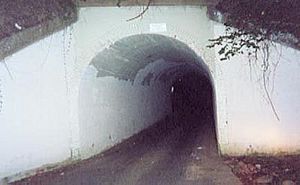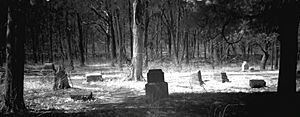Urban legends and myths facts for kids
An urban legend is a story that isn't true but is often told as if it really happened. These stories are usually shared by word of mouth, or through things like emails and social media. People often say they heard the story from a "friend of a friend." Urban legends can be funny, scary, or even teach a lesson. They often involve mysterious dangers, strange events, or unusual creatures. These tales can also show what people worry about in society. Some urban legends have been told for many years, changing only a little bit over time.
Contents
What Are Urban Legends?
The term "urban legend" was first used by experts who study folklore, like Richard Dorson, in the late 1960s. Jan Harold Brunvand, a professor, helped make the term popular in the 1980s with his books. He showed that legends aren't just old stories from long ago. They are also part of our modern culture. By studying these tales, we can learn a lot about how people think and what they believe today.
How Urban Legends Are Built
Many urban legends are like short stories with a plot and characters. They often grab our attention because they have elements of mystery, fear, or humor. A lot of them act as warning stories. They might show someone doing something wrong and then getting into trouble, hurt, or even worse.
Urban legends often try to make the reader feel a bit grossed out or shocked. This makes the stories more memorable and powerful. Many urban legends also include things that are supernatural or paranormal, like ghosts or strange creatures.
How Urban Legends Spread
Some urban legends might have started from real events, but they get changed a lot over time. For example, the story of "The Death Car" might have come from a real event in Michigan. The idea that Coca-Cola made Fanta for Nazi Germany during World War II is based on the true story of Max Keith, who ran Coca-Cola's operations in Germany and created Fanta.
When someone tells an urban legend, they often say it happened to a friend or a "friend of a friend." This makes the story feel more real and personal, even if the teller knows it's just a tale. Many urban legends talk about scary crimes, bad food, or other things that could affect many people. If someone believes these stories, they might feel like they need to warn their family and friends. Sometimes, even news channels or police have shared warnings about these rumored threats.
For example, there was a rumor called "Lights Out." It said that gang members would drive without headlights. If a kind driver flashed their lights to warn them, a new gang member would have to attack that driver as part of their initiation. This rumor spread widely, even reaching government officials who thought it was a real threat.
Common Parts of Urban Legends
Urban legends usually have a few things in common:
- The story is told as if it happened to someone else.
- They often give strong warnings about what might happen if you don't listen to the advice in the story.
- The story is often introduced as "something a friend told me," but the friend is usually not fully identified.
These stories often seem believable and exciting, which makes people want to share them, especially on social media. Many urban legends are actually just long jokes that are told as if they were true. Some urban legends stay popular for a long time because they sound like they *could* be true. For instance, the story of a serial killer hiding in the back seat of a car. Another example is the rumor from the 1970s that the Procter & Gamble company was linked to Satan worship because of its old logo. This rumor caused so many problems for the company that they stopped using the logo.
Urban Legends and Old Stories
The earliest name for these stories was "urban belief tales." This showed that people telling them truly believed they were real. The idea of a "Friend of a Friend" (FOAF) was a way to make the stories seem more real. While some legends, like "The Death Car," might have a small bit of truth, experts are interested in why these stories are told and believed, even if they aren't true. Just like old myths, urban legends are believed because they fit with what a group of people already think about the world. They can also help explain confusing events.
Experts who study society use urban legends to understand why people believe certain things. For example, they look at how these stories relate to ideas about crime, childcare, or fast food. They see a link between urban legends and older folk tales, like Grimm's Fairy Tales, which have similar themes. This is why people who believe these stories often get upset when told they aren't true. For example, police officers might get angry when told that strangers rarely put bad things in Halloween candy, even though it's true.
Finding and Studying Urban Legends
The Internet has made it much easier for urban legends to spread, but also easier to prove them wrong. Websites like snopes.com are dedicated to discussing, tracking, and checking urban legends. There used to be a service called Hoaxbusters that dealt with fake stories spread by computers. Some of the most famous online hoaxes are called creepypastas. These are scary stories written by unknown authors. Most people know they aren't real, but some, like the Slender Man, have gained followers who believe in them.
Television shows have also explored urban legends. Shows like Urban Legends and MythBusters have re-enacted these stories. MythBusters even used the scientific method to try and prove or disprove them. The 1998 movie Urban Legend showed students talking about popular urban legends while also becoming victims of them.
There have also been books and comic books about urban legends, collecting many of these popular tales.
Types of Urban Legends
Health Legends
Some urban legends are about health. For example, the idea that if you eat watermelon seeds, a watermelon will grow in your stomach. Or that you'll catch a cold if you go outside right after showering.
Internet Legends
Internet urban legends are stories that spread online, often through email or social media. They can become very popular, like a viral video. Some are like chain letters, telling you to share them or something bad will happen. Others are fake virus alerts, warning you about computer threats that don't exist. These often appear as pop-ups online.
Paranormal Legends
Paranormal urban legends usually involve someone meeting something supernatural. This could be a cryptid like Bigfoot or Mothman. These are legendary creatures that many people believe in, even though there's no real proof. Research shows that when people see something sudden or surprising, like a Bigfoot, they might think the event lasted longer than it really did.
Marketing Legends
Sometimes, companies are accused of hiding "secret messages" in their logos or packaging. For example, the old Procter & Gamble symbol was rumored to be linked to Satan worship. People claimed that if you connected the thirteen stars in the symbol in a certain way, it would show three sixes in a row (the number 666). Another example is a video that went viral, claiming that Monster Energy drinks used a Hebrew alphabet symbol for the letter "M" to secretly show the number 666.
Some urban legends have been used in funny ways in advertising. For instance, the Sasquatch in Jack Link commercials, or unicorns in Icebreakers ads. The New Jersey Devils hockey team is even named after the state's popular cryptid, the Jersey Devil.
See also
 In Spanish: Leyenda urbana para niños
In Spanish: Leyenda urbana para niños
- List of urban legends
- Campfire story
- Factoid
- Old wives' tale
- Woozle effect




